How To Set Up A Leopard Gecko Tank
Leopard Geckos come from the hot and rocky desert scrubs of southwestern Asia.
A mutual misconception is Leopard Gecko should have sand in their habitat. This is a non truthful. Unfortunately a lot of misinformation exists on this species because of its popularity.
In the wild a Leopard Gecko habitat is more rocky terrain and less desert.
The most of import factors when setting up their enclosure are tank temperatures, hides and substrate.
This guide will teach you everything you demand to know nearly how to set up the best Leopard Gecko habitat then your Leo can live a long and healthy life!
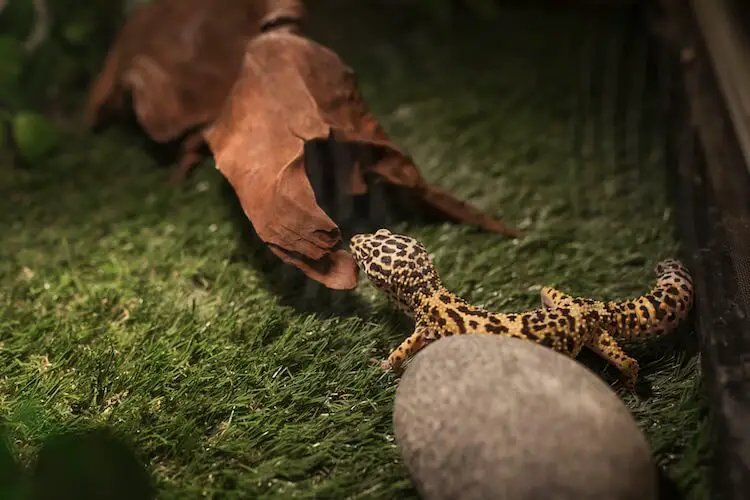
Table of Contents
- Leopard Gecko Enclosure Overview
- Types of Leopard Gecko Tanks
- What Size Tank Should I Get For A Leopard Gecko?
- All-time Leopard Gecko Enclosure
- Leopard Gecko Lighting and Heating
- Leopard Gecko Humidity
- Leopard Gecko Substrate
- Reptile Carpeting
- Newspaper
- Shelf Liner
- Alfalfa Pellets
- Sand
- Supplies, Décor and Landscaping
- All-time Leopard Gecko Setup
Leopard Gecko Enclosure Overview
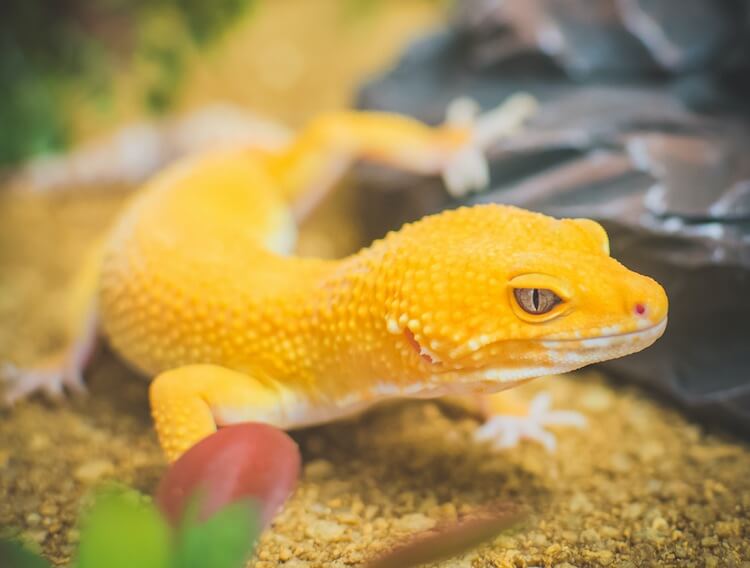
The virtually of import factor to consider for your leopard gecko's habitat is tank size.
Adult Leopard Geckos demand at least a twenty-gallon long tank. In general the larger the habitat the improve.
Anything less than a 20-gallon is mostly too modest to fit a food bowl, water bowl, decorations and hides.
Some owners chose to business firm babies in 10-gallon tanks and and then buy a larger terrarium later the starting time twelvemonth. This is non recommended as it is more than expensive and time consuming.
Types of Leopard Gecko Tanks
There are four types of leopard gecko tanks you can house your Gecko in:
- Glass
- Wood
- Mesh
- Plastic
The best textile for a terrarium is glass.
Glass Leopard Gecko enclosures are more popular and easier to observe in a variety of sizes.
You can use wood if yous actually like the advent. However, wood is a possible burn hazard and can be difficult for beginners to maintain humidity levels.
Glass
Glass tanks are very easy to clean and they maintain humidity levels well.
They likewise have transparent sides which makes it great for viewing your pet.
An advantage of glass tanks is the ability to stick thermometers, fake plants and other decorations on the glass walls.
Glass enclosures are generally lightweight then they are like shooting fish in a barrel to motion when cleaning or re-organizing the tank.
You can either buy a twenty-gallon aquarium tank (with a matching mesh top) or a reptile tank with doors that open on the side.
The only disadvantage of glass habitats is their high price. A high-quality glass tank will cost $100 to $200.
Wooden
Wooden enclosures are a expert option for owners that want a cute habitat.
Unfortunately wooden enclosures are difficult to detect and do not make applied Leopard Gecko habitats.
They are too not as practical when compared with glass tanks.
Wooden tanks are decumbent to being damaged by wear and tear from water and heat.
Finally these habitats are difficult to clean and are prone to absorbing water. This means their habitat will demand to be cleaned more frequently to prevent mold.
The cost for a wooden leopard gecko tank can range from $l to $300.
Mesh
Mesh vivariums are commonly used for reptiles that savor climbing. Veiled chameleons are housed in mesh enclosures because they are arboreal.
Leopard Geckos are non arboreal and then practice not climb. Considering of this they should be housed in tanks that are long and not tall.
Many mesh cages are tall every bit they are congenital for reptiles that like to climb. Because of this it can be hard to detect in a twenty-gallon long mesh tank suitable for a Leopard Gecko.
If you do manage to find a long 20-gallon mesh tank then consider humidity and stress.
Mesh sometimes prevents proper humidity retentiveness and the visible open infinite might stress your Gecko.
Plastic
Plastic enclosures are the cheapest selection on this listing.
They volition unremarkably cost $20 to $xxx.
Plastic tanks are normally an eyesore and practice non look every bit practiced every bit wooden or glass enclosures.
If you do decide to buy a plastic enclosure then make sure that it is not-toxic and PVC free.
What Size Tank Should I Get For A Leopard Gecko?
Juveniles require a 10-gallon long tank. Nonetheless, it is ameliorate if yous tin purchase an adult enclosure from the start. Adult Leopard Geckos need at least a 20-gallon long tank. A xx-gallon tank size also provides plenty space for a Gecko to roam and explore.
If you lot make up one's mind to buy a smaller starter tank remember juveniles grow fast. Every three months they grow an extra inch.
Every bit soon equally they measure over six inches they need a 20-gallon long habitat.
It is not recommended to firm 2 leopard geckos together.
Housing more one Gecko in the same habitat tin can lead to injuries or decease due to territorial aggression. Aggression is common in both males and females.
If you decide to house multiple Geckos together use a 30-gallon tank with multiple hides so each has their ain space.
Best Leopard Gecko Enclosure
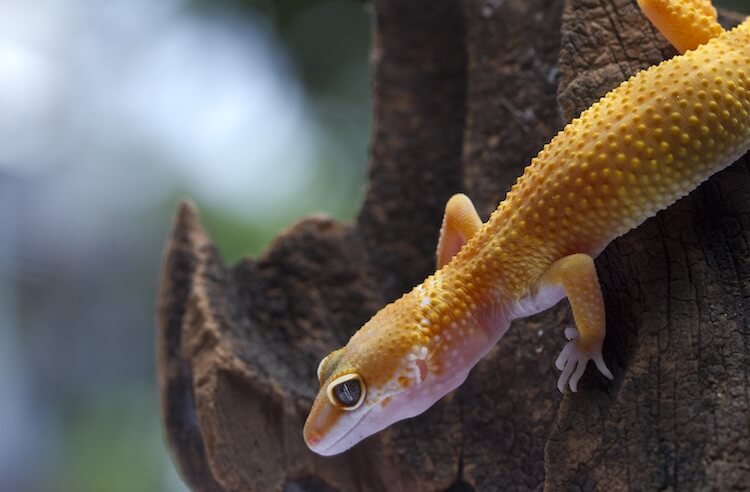
The best habitat for your Leopard Gecko is a 20-gallon long glass tank.
Glass provides a surface for thermometers and decorations, is extremely easy to clean and move and makes observing your Gecko fun.
They tin can exist more than expensive than other tank types but glass' functionality is far superior.
Leopard Gecko Lighting and Heating
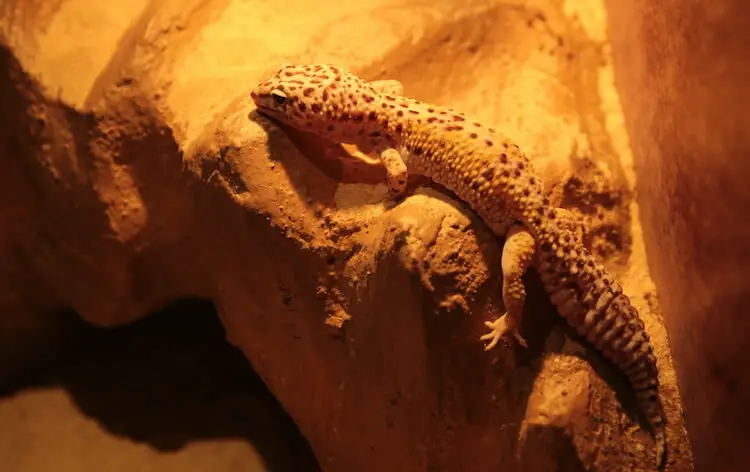
During the day your Leopard Gecko volition need a heat gradient of 90°F to 75°F. The warm side of their tank should accomplish 90°F and not be hotter than 95°F.
In gild to estrus their habitat y'all will need to utilise a proper heat source. A ceramic heat emitter is the best pick. Make sure you connect it to a thermostat (read thermostat not thermometer!) to command the heat.
You will need to identify a thirteen to 25-watt UVB seedling on the hot side of their tank. Make sure the bulb is below 6% and is but on for x hours a day.
Although a UVB low-cal is not required having one can exist beneficial for your Leopard Gecko. In my experience I have seen that many Geckos seem healthier and more vibrant with a UVB low-cal.
Make certain their UVB light is non too bright as it can impairment their optics.
By placing the seedling on one side of the tank it will form a natural heat gradient.
If you lot make up one's mind non to use a UVB light make certain to use a D3 supplement.
At night permit tank temperature to drop to just above 70°F.
Leopard Gecko Humidity
Dissimilar other tropical geckos Leopard Geckos should have a humidity level of 30 to 40%. You will need to buy a hygrometer to monitor humidity. Stick it to the side of your drinking glass terrarium.
Keeping humidity levels at 30% tin can be hard but under 40% humidity should exist easy to maintain.
If humidity levels are as well low and so place a pocket-size basin of h2o close to the basking lite.
The water level should not be higher than your Gecko'southward ears as this tin crusade drowning.
Y'all should too put moisture sphagnum moss in a hibernate as well. When Leopard Geckos shed their skin a humid hide will help. You volition need a cavern-similar hide with one enter/exit hole. Make certain that this designated hide is near the hot side of their habitat.
If you lot find that humidity is too high, and then move the h2o bowl abroad from your heat lamp. If still humidity remains high, make sure to check your that substrate (e.g. reptile carpet) is not retaining any h2o.
Leopard Gecko Substrate
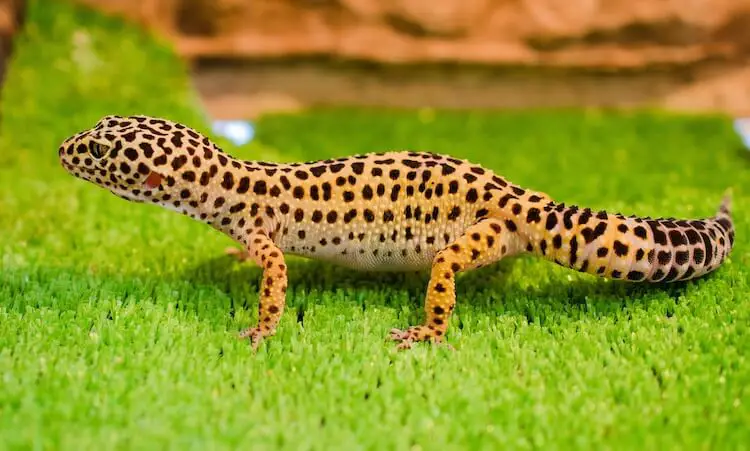
Ane of the most controversial and misunderstood aspects of setting up a Leopard Gecko Habitat is their substrate.
A common and dangerous misconception is that Leopard Geckos live on sand.
Any form of loose substrate similar sand poses an impaction risk. Impaction is a blocked bowel because you lot reptile has eaten something it cannot assimilate.
It is highly recommended you practise not use any type of loose substrate.
Luckily, there are countless substrates that are easy to clean and pose no risk of impaction…
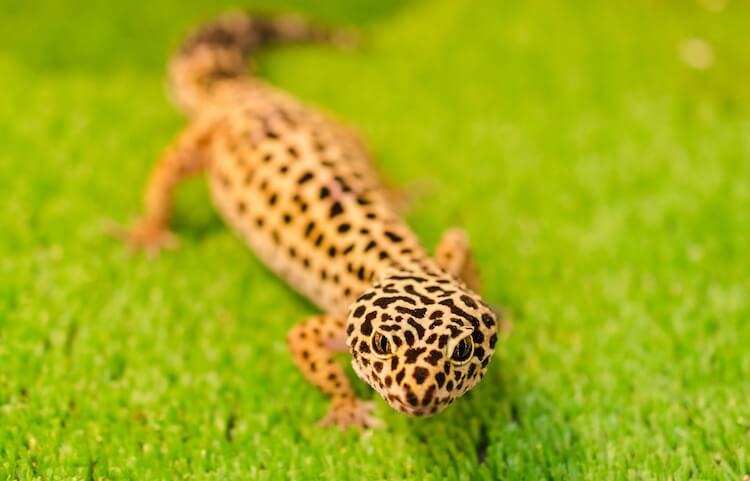
Reptile Carpet
Reptile rug (pictured above) is an astroturf-similar material that is specifically made for reptile habitats.
Many owners use reptile carpet because it is hardwearing, reusable and cheap.
If you buy reptile carpet and then get ii. You volition need to wait a twenty-four hour period for it to dry entirely after cleaning – otherwise you tin can accidentally increase tank humidity.
The only disadvantage of reptile carpet is the bogus loops can snag your Leopard Gecko'due south claws and cause injury.
Newspaper
Paper is too a great substrate for Leopard Geckos. It is costless and dry.
Paper towels are besides a practiced substrate for the same reasons.
Both substrates are piece of cake to clean and replace. The all-time way to keep the newspaper clean is to spot clean daily and replace it weekly.
Unfortunately paper is ugly and then does not work for owners that want a themed tank.
Shelf Liner
Shelf liner is a neat substrate for a Leopard Gecko's tank.
Shelf liner is any sort of rubber matting that is used to place in kitchen cabinets.
Many people use this liner due to its depression water retention and considering information technology is easy to clean.
It is also a keen selection because it comes in many different patterns and designs.
Shelf liner also comes in larger rolls so you lot can replace it every few weeks.
Make sure to use a non-adhesive shelf liner. Sticky shelf liner is not merely hard to supersede only it can accept toxic chemicals in the glue.
Alfalfa Pellets
Alfalfa pellets are modest nutrient pellets fed to rabbits and other small mammals.
There are some benefits to using Alfalfa Pellets equally a substrate such as it retains heat well and keeps bacteria out.
Information technology is common to come across Alfalfa Pellets beingness used in a Bearded Dragon tank.
Unfortunately this substrate should non be used because its small size poses a risk of impaction.
Sand
Sand is an umbrella term for substrate that covers products like reptile sand and calcium sand.
Many beginners utilize sand as it is sold at pet stores.
Sand is aesthetically pleasing and it seems like information technology would exist a good idea considering these Geckos come the deserts of Pakistan, Iran, Republic of iraq and Transitional islamic state of afghanistan.
Notwithstanding, this substrate poses many wellness risks for your Leopard Gecko.
Sand should never be used for your Leopard Gecko's habitat.
If a Leopard Gecko accidentally eats sand it tin block their intestine. This leads to many health problems and potentially premature death.
Supplies, Décor and Landscaping
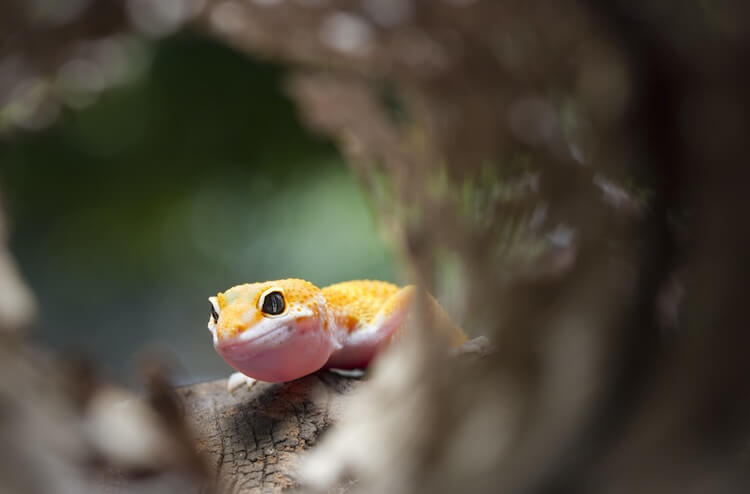
The decor and supplies yous place in a Leopard Gecko's habitat should enrich their tank and get in natural.
In the wild Leopard Geckos hide from predators in pocket-size spaces and crevices to escape from potential danger. Then a proficient Leopard Gecko habitat should provide at least 3 hides:
- The first hide should be placed on the hot side of the tank.
- This 2nd hide is a boiling hide with moisture sphagnum moss.
- A concluding hide should exist placed on the absurd hide.
Many owners build their own hides using a Tupperware with a hole cut out. Annihilation that retains humidity well is a functional hibernate. Having more three hides will give your Gecko many places to explore and rest.
Fifty-fifty though this species does not have gluey toe pads like a Gargoyle Gecko they still beloved to explore.
I would encourage you to place decor that allows them to explore. My Leopard Gecko loves his reptile hammock and laying on top of a rock ledge.
Simply make sure to not place any rocks or decor too high. This volition assistance to forestall injuries from falling.
Calculation fake plants and branches for your Gecko to climb on is ever a good idea. It provides enrichment and adds charm to a tank. Existent branches should be placed in boiling water for at least fifteen minutes to ensure that they are disinfected before placing them in the tank.
Finally, you will need a h2o bowl in their enclosure.
Brand sure that the h2o bowl is not besides deep. Information technology should be below ear level in order to foreclose drowning.
All-time Leopard Gecko Setup
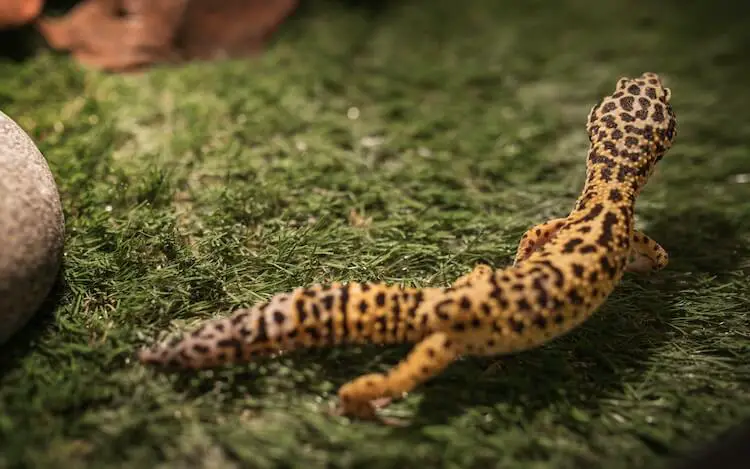
Setting upwards a Leopard Gecko habitat tin can feel daunting. Hopefully by now you know exactly what you demand!
Below nosotros accept made a list of everything you should include to make sure your Gecko loves his tank:
- xx-gallon glass reptile terrarium.
- Non-adhesive shelf liner for substrate.
- Three hides (hot, humid and absurd).
- Fake plants and branches.
- H2o and food bowls.
- Ceramic heat emitter and lamp.
- 25-watt UVB bulb (no more than 6%).
- Thermostat, thermometer and hygrometer.
Information technology is important to remember that your Leopard Gecko needs a xx-gallon long tank that is ideally made from glass.
A tank needs a rut source and the all-time one to utilize is a ceramic rut emitter. Provide a temperature slope from xc°F to 75°F. A UVB tube calorie-free is recommended too – but this is optional.
Your tank will need to take humidity of 30 to 40% that should be monitored with a hygrometer.
There are multiple substrates available, but paper towels, newspaper, reptile carpet, or shelf liner all work very well. Recollect to always avert loose substrate, as it can pb to impaction.
Have y'all discovered anything interesting to add together to your enclosure? How did you lot prepare your Leopard Gecko'southward tank? Permit u.s.a. know below.
Source: https://www.everythingreptiles.com/leopard-gecko-habitat/

0 Response to "How To Set Up A Leopard Gecko Tank"
Post a Comment